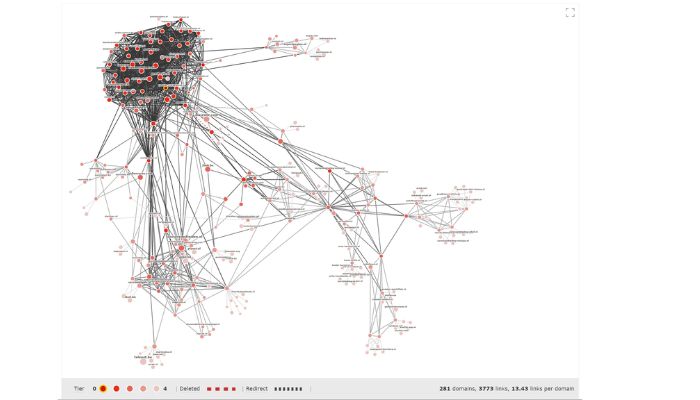Sustaining an Organic Link Structure: Guide to SEO Success
The right natural link structure can make all the difference in SEO success. No longer is it just a matter […] The post Sustaining an Organic Link Structure: Guide to SEO Success appeared first on ReadWrite.

The right natural link structure can make all the difference in SEO success. No longer is it just a matter of quantity; quality organic link building is what really counts. In order to get ahead, businesses need to gain an understanding of natural link graphs on the web and how to properly maintain one.
From creating shareable content and obtaining links from diverse sources to closely monitoring performance with SEO tools – there are definitely strategies you’ll want to keep in mind if cultivating top-notch organic linking is your goal.
This guide will discuss key factors that should be respected when attempting to develop a healthy and successful setup for search engines and audiences alike.
Tips for Maintaining a Natural Linkgraph

Source: SEO.co
Quality Content Creation
Creating content of high quality is crucial for building a robust natural link graph. When done properly, it can result in organic backlinks pointing to your website or brand. Quality content encompasses valuable, informative, and shareable pieces and caters to the target audience’s needs or interests.
Writing articles that people genuinely find interesting increases the chances that they might share them with others online, which can lead to potential submission links from directories or blog networks.
Good content can also build a reputation as an industry thought leader or trendsetter by providing unique insights into topics that readers may have otherwise gone underappreciated without contextually relevant perspectives.
In other words – good content leads to more eyeballs, social signals, and referral traffic, all of which must support a sustainable link building strategy.
Outreach and Relationship Building
Outreach and relationship building are essential elements to maintaining an organic link structure. When considering which potential sources to target with outreach, influencers, and prominent sites should always be at the top of the list, as these types of relationships translate into more measurable links than, say, lower-level authors or website owners.
Additionally, it’s important to avoid simply treating these interactions like transactions if you want to invest in sustaining an organic network.
Focus on creating useful and relevant content that will serve both tools organically; aim for longevity over short-term profit opportunities. As you build genuine connections with industry experts, bloggers, ect., open opportunities will present themselves for hosted content and dofollow backlinks – often without having asked.
Guest Blogging with Integrity
Guest blogging is a great way to establish domain authority and garner natural links, but it must be undertaken with integrity for successful SEO.
That means writing high-quality content that adds value without excessive self-promotion or keyword stuffing and only submitting articles on relevant and authoritative websites. It also means connecting in an authentic fashion with influencers, bloggers, and industry experts before asking for potential link exchanges or backlinks.
Building mutually beneficial relationships helps ensure the best chance of getting your content accepted on popular sites in exchange for links or shared posts. By taking the time to ensure you’re presenting yourself well while guest posting, you can maximize its potential SEO benefits by avoiding penalties linked to low-quality link schemes.
Avoiding Black Hat Practices
Black hat techniques involve taking shortcuts with a link building strategy to get quick, unethical SEO results. Avoiding all types of black hat practices is the key to successfully sustaining an organic link structure.
Firstly, stay clear from buying links glaring signals for search engines that a website might be using underhanded tactics for ranking purposes. Also, steer away from automated software and spun content.
Every attempt to game the system only leads to long-term damage in your overall link portfolio as well as greater chances of facing stiff penalties by search engines like Google. Lastly, make each backlink count – only approve high-quality links with higher relevancy values when seeking new and fresh opportunities for acquiring additional healthier anchors into your live portfolio.
Diversification of Link Sources
Diversification of link sources is an important component of maintaining a healthy, natural link graph. This involves obtaining links from different types of websites, such as blogs, forums, directories, news sites, and more.
To truly diversify your link profile, necessary effort must be put into developing relationships with authentic sources all around the web who can provide relevant content or even something as simple as brand mentions which can bring in valuable backlinks.
Furthermore, it’s also crucial to diversify the anchor text for other facets, but this (brand names+ keyword variations.) Doing so will help protect against search engine penalties while still receiving benefits to build up domain authority over time.
Monitoring and Adjusting Your Linkgraph
Utilizing SEO tools to track backlinks
With such a tool, webmasters can easily assess the quality and quantity of links connected to their websites or domains. Furthermore, it allows them to evaluate the effects their link graph progresses are having on authoritative signals and root out potential issues down the road.
By reviewing key metrics such as quantity vs. quality ratio or domain/page authority scorers, marketers can identify opportunities for improvement and detect potentially dangerous links before they cause trouble in search rankings.
Regularly auditing and removing harmful or irrelevant links
Maintaining an organic link structure is essential for successful SEO. As part of the process, regularly auditing existing backlinks and removing any irrelevant or potentially harmful links can have a significant impact on your ranking and website credibility.
Doing so helps to ensure that only relevant and quality websites are linking to yours – within Google’s webmaster guidelines.
Doing regular audits helps you identify toxic links from sources such as black-hat scrapers, comment spam, and low-quality directories, which don’t contribute anything positive to your rankings.
You must proactively manage those shady link schemes coming in by contacting anyone who has linked unethically before they become a problem for your business or website visibility. Removing negative backlinks creates a more naturally shaped backlink profile and ultimately increases SEO potential.
Adapting strategies based on performance and industry trends
Regularly monitoring your link profile allows you to stay informed on which links are helping or hindering SEO progress, as well as keep up with the latest algorithms and updates from search engines.
Having this holistic view enables you to continually adjust your approach in order to obtain only high-quality links that truly benefit the overall SEO score and reach short-term goals. It also encourages diversification of sources since relying solely on manual outreach can open up websites to disavowal regulations by search engines if deemed unchecked.
In employing website evaluation tools for tracking, analysis, and comparison purposes – companies are given valuable insights as to what should be used tactically next for the best results.
Conclusion
Maintaining a healthy and organic link structure is essential for improving search engine rankings and website visibility.
Quality content creation, outreach and relationship building through reputable sources, engaging in ethical guest blogging practices, diversifying the types of websites linked to your page, monitoring and adjusting as needed; each of these factors plays an important part in creating long-term SEO success by enabling your website to foster a natural link graph.
Effectively optimizing what links you choose to engage with can prove beneficial for increasing ROI by exhibiting credibility amongst both search engines and readers alike while garnering great attention from potential customers.
Those passionate about embracing their knowledge into finding solutions that are not only sustainable but also superior should prioritize safeguarding matchless methods enforced by enduring trustworthiness which will all reflect naturally in their link graphs.
![]()
Nate Nead
Nate Nead is the CEO & Managing Member of Nead, LLC, a consulting company that provides strategic advisory services across multiple disciplines including finance, marketing and software development. For over a decade Nate had provided strategic guidance on M&A, capital procurement, technology and marketing solutions for some of the most well-known online brands. He and his team advise Fortune 500 and SMB clients alike. The team is based in Seattle, Washington; El Paso, Texas and West Palm Beach, Florida.

 BigThink
BigThink 































